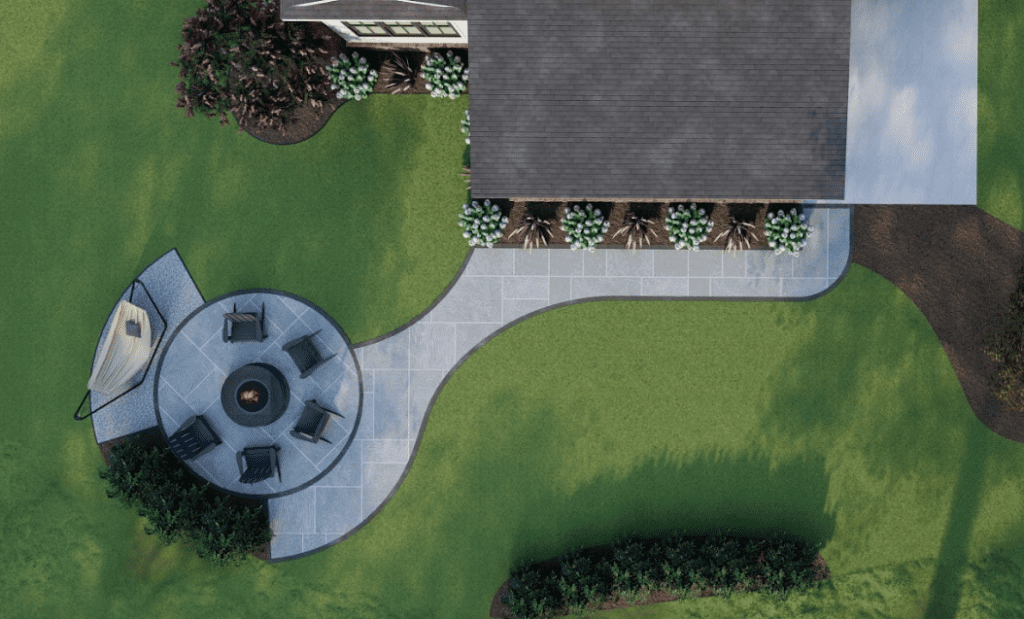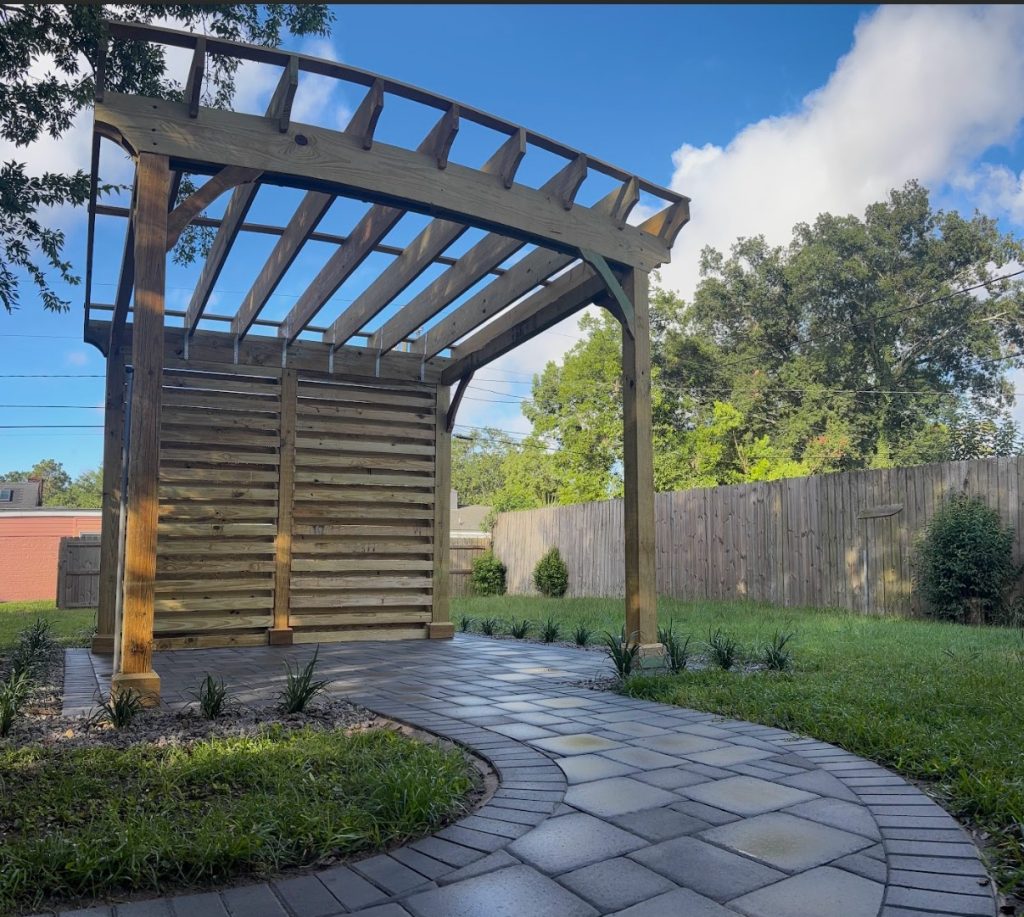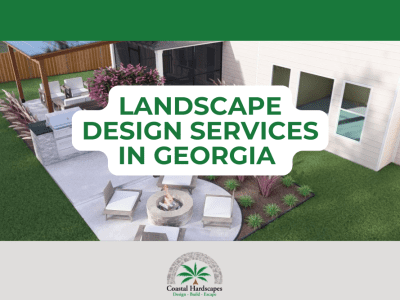Are you looking for landscape design help near you? Finding a landscaping design company can be complicated with most companies either specializing in design or installation, but not both.
Here at Coastal Hardscape of Savannah, GA, we are one of the rare companies that has an in-house design team and also installs landscapes and hardscape projects we help you create! Today, we will walk you through how to find a landscape designer near you!
What Makes Landscape Design in Georgia Unique
Landscape design in Georgia—especially around Savannah—means working with a climate and environment that national magazines rarely take into account. Our long, humid summers require heat-tolerant shrubs, grasses, and native plants that stay healthy through months of intense sun. Soil conditions shift from sandy coastal ground to pockets of red clay, which affects drainage, root depth, and how patios or walkways must be built to prevent shifting or cracking.
Seasonal storms and heavy rain make innovative water management essential. Proper grading, French drains, and adequate irrigation planning help prevent standing water from damaging your yard or hardscape. And because Savannah homeowners enjoy their outdoor spaces year-round, thoughtful patios, seating areas, and lighting are just as important as the plants you choose.
Georgia landscape design succeeds when it works with the climate, soil, and lifestyle—rewarding intentional planning and professional guidance.
Quick Homeowner Checklist for Landscape Design
Do you want to know how to prepare for a landscape design service? Keep reading below.
Before choosing plants or starting any digging, use this brief checklist to understand your yard. It keeps decisions grounded in reality rather than in impulse, but also lets you better understand the landscape design process!
Factors to Consider:
Sunlight
- Which areas get full sun (6+ hours)
- Which areas get partial sun (3–6 hours)
- Which areas stay shaded most of the day
Drainage
- Where does rainwater naturally move?
- Any low spots that stay soggy?
- Does water flow toward the house or away?
Soil
- Is your soil sandy, clay-heavy, or a mix?
- Does it clump tightly or fall apart easily?
- Have you tested pH at least once?
Lifestyle
- How much time are you willing to spend maintaining plants each month?
- Do children or pets use the yard?
- Do you want a quiet retreat, a social space, or a place with curb appeal?
Budget & Time
- Are you planning to do everything at once or in phases?
- Do you prefer DIY with guidance or a complete professional build?
Step 1: Start With a Plan That Fits Your Yard and Your Lifestyle

A great yard starts with clarity. Before buying plants or calling the mulch truck, you need a plan that matches your lifestyle. For example, one new patio project in Westbrook, Pooler, wanted to integrate their hardscaping and landscaping to enhance the views of the water behind the home at night.
Before starting any landscape design project, take time to study your yard the way a professional would. Walk it at different times of day to see how sunlight and shade truly shift—because the perfect plant in the wrong light will never thrive. After a rain, notice where water pools or drains too quickly; these areas indicate where to place plants and hardscape. Consider how you intend to use the space, whether it’s for relaxation, hosting, or providing a space for kids and pets to play, and select a style that genuinely suits your taste, rather than a collection of random ideas.
Select plants that match your maintenance comfort level, and build structure with hardscaping first so your layout feels intentional. And when grading, drainage, or complex layouts come into play, calling a professional like Coastal Hardscapes of Georgia ensures the design works beautifully from day one.
Step 2: Find a Professional Landscape Design Company
Once you have your vision in mind, don’t get carried away picking out plants or designing your outdoor living area. What you will need to do instead is ensure you select the right landscaping company that can specialize in both the design and installation of your project.
While there are firms that can offer each service separately, it is better to go with a landscaping company that offers both for budget aspects, but also a better understanding of all the aspects you are looking for.
Here is what we recommend you do to pick the best landscaping company near you:
- Check their local experience — Choose a company that understands Georgia’s heat, humidity, soil types, and storm patterns. Local knowledge = better results.
- Review past projects — Look for before/after photos, patios, drainage work, and plant selections similar to what you want.
- Verify licenses & insurance — Ensure they’re properly insured and certified to work in hardscaping, grading, or irrigation.
- Ask about materials & warranties — A good company will explain what they use, why they use it, and what’s covered long-term.
- Get a detailed quote — Compare scope, timelines, and pricing—not just the lowest number. Clear communication upfront prevents surprises later.
Step 3: Pick the Best Plants for a Year-Round Landscape Design in Georgia
Once you have your goal in mind and your company of choice, the next step is to start thinking about plants! For example, here at Coastal Hardscapes, we will walk you through our recommended plants, but also allow for you to add texture and depth to your landscape design!
A local landscaping company is vital because it will help you select plants that remain attractive in Georgia’s heat, humidity, and seasonal fluctuations. The table below compares reliable choices and what they contribute.
| Plant Name | Type | Best Season Interest | Key Benefits | Ideal Placement |
|---|---|---|---|---|
| Loropetalum | Evergreen Shrub | Winter/Spring | Holds color year-round, low maintenance | Foundation borders, privacy edges |
| Azalea (Southern Varieties) | Flowering Shrub | Spring | Strong seasonal blooms, iconic Georgia look | Part shade areas under trees |
| Lantana | Perennial Flower | Summer | Heat and drought tolerant, attracts pollinators | Sunny open beds and borders |
| Muhly Grass | Ornamental Grass | Fall | Soft pink plumes add movement and texture | Accent point near patios or walkways |
| Holly (Dwarf Varieties or Nellie R. Stevens) | Evergreen Shrub | Winter | Berry color in colder months, privacy screen | Perimeter lines or stand-alone accents |
| Magnolia (Little Gem) | Small Evergreen Tree | Year-Round | Classic Southern character, strong structure | Center focal points or anchoring corners |
Why do we recommend the above? These plants work together: evergreens provide structure, while seasonal flowers and grasses add color and rhythm throughout the year.
Step 4: Add Hardscaping Features That Make Your Yard Feel Finished

Once you complete your vision and hire the right company, selecting your plants is fun, but the real fun starts with adding hardscape features to your landscape design!
Hardscaping gives your yard structure. Plants fill in the space, but the built elements like patios, walkways, and pergolas shape how you move and use it. Here are six features that make sense for Georgia homes.
- Paver Patios: Stable and long-lasting. They stay cooler than poured concrete in the Georgia sun. They also provide a comfortable place to sit and enjoy outdoor meals.
- Walkways and Garden Paths: Paths guide movement and prevent grass from wearing into muddy strips. Use stone, brick, or pavers to match your home’s style.
- Retaining or Seating Walls: Useful for sloped yards. They prevent soil erosion and create flat areas for planting. Short walls can double as seating during gatherings.
- Defined Bed Edging: Clear edges help your yard look maintained, even when plants are between bloom cycles. Stone, metal, or brick edging works better than plastic because it stays put.
- Fire Pits or Outdoor Fireplaces: These add warmth on cooler Georgia evenings and create a natural gathering spot. They also make the yard enjoyable year-round.
- Grill or Outdoor Kitchen Zones: If you like to host, a simple counter beside the grill keeps everything organized. It turns a patio into a functional outdoor room rather than a collection of furniture.
Step 6: Water, Lighting, and Outdoor Comfort Features That Add Real Use
One unique way to add to your outdoor living area on a budget is with lighting and other features, such as fans or shade (a must in hot Savannah Georgia).
Soft sound, gentle light, and comfortable seating areas can change how your yard feels. A minor water feature cools the space and adds movement. Landscape lighting extends outdoor time and makes walkways safer at night. Covered seating, fans, or shade sails help you enjoy the yard during warm afternoons.
These additions are not only visual. They help your outdoor areas feel welcoming and practical during more months of the year.
Cost Guide for Landscape Design in Georgia
Think of landscape design as a combination of planning. However, the design can also estimate other costs, such as materials and skilled labor. The goal is to create an outdoor space that reflects how you live and withstands Georgia’s humidity, sun, and seasonal rain.
The price changes based on yard size, soil conditions, drainage, equipment access, and the elements you want to include. The table below gives a clear comparison.
| Project Scope | What You Get | Typical Price Range in Georgia | What This Level Accomplishes |
|---|---|---|---|
| Design-Only Plan | Measured layout, planting list, material suggestions, install notes | $450 to $2,500 | A clear blueprint so you avoid trial-and-error mistakes. Good for DIY or phased work. |
| Front Yard Refresh | Shrubs, groundcovers, mulch, edging, basic walkway | $2,500 to $8,500 | Fresh curb appeal that looks organized and well cared for. |
| Backyard Planting + Seating Zone | Beds, sod, small patio, accent lighting | $6,500 to $18,000 | Creates a usable space for daily living and simple hosting. |
| Paver Patio and Hardscape Features | Paver surface, steps, small wall, integrated lighting | $12,000 to $32,000+ | Durable outdoor living space that lasts for years. |
| Full Outdoor Living Transformation | Patio, kitchen or fire feature, drainage, grading, full plant design | $25,000 to $85,000+ | A complete backyard designed for comfort and long-term enjoyment. |
Why does the cost of landscape design vary?
There are numerous factors that landscape design firms consider when pricing plans. A simple plan with some plants and a few mulch beds is easier to complete than a design plan that includes grading, water, hardscaping, and greater complexity.
Here are the most common factors that contribute to landscape design costs:
- Soil and grading may require correction before installation.
- Material selection (concrete, pavers, natural stone) significantly affects price.
- Site access can increase labor time if the machinery can’t reach the yard easily.
- Design complexity affects planning and build steps.
Landscape design is not just about installing plants. It is creating outdoor space that fits how you live, holds up in Georgia’s climate, and remains visually appealing across seasons.
Note: Pricing can shift based on the layout, materials, and conditions specific to your property. For the most accurate cost breakdown, contact us for a free hardscaping consultation. We’ll assess your yard, discuss your goals, and provide a custom plan that fits your priorities and budget.
Landscape Design Near Me: When to Bring in a Professional

Working on your yard can feel rewarding. You can plant a few shrubs, spread mulch, and keep things tidy. But some situations ask for trained eyes, engineering sense, and local experience. Here are six clear scenarios where bringing in a professional protects your time, home, and budget.
1. When Water Stays Where It Shouldn’t
Water that sits for more than a day is not just inconvenient. It often tells you the grade is off or the soil has compacted. Georgia clay holds moisture tightly, so puddles linger.
Real scenario:
A homeowner in Richmond Hill planted hydrangeas in a low spot. After every storm, they sat in standing water. The leaves yellowed. Root rot set in. The plants died within one season. A landscape professional later corrected the slope and added a simple drainage trench. The same spot now supports healthy shrubs.
Moral: Correct the water first or nothing else survives.
Quick signs to watch:
- Mud patches that never dry
- Grass thinning near the home
- Water running toward the foundation
2. When You Want a Patio or Walkway to Last Longer Than One Season
A stable patio needs a compacted base, correct depth, and attention to soil movement. Georgia soil expands in wet weather and contracts in dry weather. If the base is wrong, surfaces shift.
Real scenario:
A DIY paver patio in Pooler looked great for the first three months. Then the rain came. The center sank about two inches. The homeowner tried adding sand, but the problem was below the surface. A professional rebuilt the base correctly. It hasn’t moved since.
Moral: The part you don’t see is the part that matters most.
Keep in mind:
- Patios need a deep, compacted foundation
- Clay movement is predictable, but must be accounted for
3. When Plant Choices Feel Like Guesswork
Garden centers sell plants that look good today. Many of them do not handle Georgia summers. A professional selects plants for long-term growth, soil match, and sun exposure.
Real scenario:
A homeowner in Savannah loved hydrangeas and lined the front walkway with them. The walkway got full sun from 11 a.m. to 5 p.m. every day. The hydrangeas scorched. The soil stayed dry. After replacing them twice, the homeowner switched to gardenias. They now look full, green, and steady.
Moral: Choose plants for the location, not for the photo.
Ask yourself:
- How much sun does the spot get
- How often will you water
- Will the plant hold shape over the years
4. When Your Yard Has a Slope or Uneven Ground
Sloped land can be beautiful, but it requires support to be safe and usable. Retaining walls are not just stacks of stone. They resist pressure and must drain properly.
Real scenario:
A family in Rincon built a low block wall to level an area for a playset. After a heavy rain, the wall bowed outward. The soil behind it was pushing with more force than the blocks could handle. A professional rebuilt the wall with drainage stone and a proper footer.
Moral: Gravity always wins if the structure is not built right.
Key considerations:
- Soil pressure increases when wet
- Walls need drainage relief behind them
5. When You Want the Yard to Feel Cohesive
Most homeowners improve their yard in stages. Without a plan, early steps often get ripped out when the next stage arrives.
Real scenario:
A couple in Savannah installed a patio first. Later, they wanted a small outdoor kitchen. The patio had to be partially removed because there was no room for the utilities. A plan from the start would have positioned everything correctly.
Moral: A long-term plan saves money in the long run.
Phase-friendly approach:
- Start with drainage and grading
- Add hardscaping
- Layer plants after
6. When You Want to Build in Phases
Most homeowners improve their yard in stages. Without a plan, early steps often get ripped out when the next stage arrives.
Real scenario:
A couple in Savannah installed a patio first. Later, they wanted a small outdoor kitchen. The patio had to be partially removed because there was no room for the utilities. A plan from the start would have positioned everything correctly.
Moral: A long-term plan saves money in the long run.
Phase-friendly approach:
- Start with drainage and grading
- Add hardscaping
- Layer plants after
Final Word on Landscape Design:
Your outdoor space should feel comfortable, welcoming, and lived in, but how do you design that?
Most people have a landscape that is either too bare or too crowded. However, with this guide’s thoughtful design and the right combination of hardscape and plant choices, we can make that happen. Coastal Hardscapes works throughout Savannah, Pooler, Rincon, Richmond Hill, and nearby areas.
Call us today and let’s build your space with confidence.
FAQ: Landscape Design in GA
1. Why is landscape design in Savannah different from that in other cities?
Savannah’s coastal climate, heavy rainfall, and varied soil types—ranging from sandy to dense clay—require designs that manage water well and withstand long, humid seasons.
2. What makes landscape design in Pooler unique?
Pooler’s mix of clay and sandy soils, along with long, humid summers, requires careful plant selection, proper drainage, and heat-tolerant materials. To find a great landscape design in Pooler, Ga, just reach out to us below!


 Buckhead Travertine Pool Deck Repair: Restoring Beauty & Safety
Buckhead Travertine Pool Deck Repair: Restoring Beauty & Safety